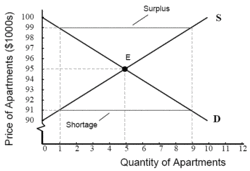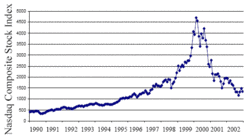Market dynamics (People)
Contents
Market dynamics
| Topics: |
While supply-and-demand analysis can be a very useful tool, not every market is a perfectly competitive spot market with smoothly-functioning double-auction mechanisms. Markets may be characterized by market power, differentiated goods, imperfect information, long-term contracts or very different approaches to price determination. An issue of particular importance to macroeconomics is the question of the speed at which real-world price adjustments take place.
When Price Adjustments are Slow

How long will it take our hypothetical condo traders to reach equilibrium? Minutes? An hour? A day? The theory of supply and demand doesn’t tell us. The graphs represent a static model.
Some markets, like stock markets in which traders are constantly yelling bids to each other, clear quickly. But what if you don’t have everyone in a room, agreeing on trades minute-by-minute? For example, consider the market for shirts. When you go into a clothing store, you see a rack of shirts and, on their tags, a given price. The price probably reflects a mark-up by the retailer over what he or she paid to a distributor to get the shirts. The distributor in turn probably charged a mark-up over the price charged by the manufacturer. Now, if the shirts are overpriced, they won’t sell very well. In the terms we introduced, there will be a surplus. If the market worked like the perfect doubleprice and quantity to get it just right, similar to what we saw for our hypothetical apartment market in Figure 1. The price would fall, the surplus of shirts would disappear immediately, and equilibrium would be restored.
In a realistic, complicated case such as this one, however, there is actually a chain of markets involved—the manufacturer sells to the distributor, the distributor to the retailer, and the retailer to the final buyer. A quick adjustment of prices is unlikely. More commonly, while retailers may mark down the prices on the shirts they have in stock in order to clear them out, this drop in the price won’t immediately travel back up the supply chain. In the next order the retailers place with their distributors, the retailers may just ask for a smaller quantity of shirts, at the price at which the distributor is offering them—especially if the retailer is small relative to the distributor and has little power to bargain over prices. Any changes in prices or quantities at the manufacturing level will only develop over time, as the manufacturers see the level of their inventories either rise (because the shirts are not selling) or fall (because the distributors order more).
Because of the time it takes for all these things to happen, some economists believe that the most likely first response to a surplus situation is that manufacturers will cut production—perhaps laying off workers—rather than reducing their price. In this case, the quantity produced adjusts to meet the quantity demanded at a given price, rather than the price adjusting to clear the market. If such quantity adjustments happen economy-wide, unemployment could rise.
Suppliers may also be reluctant to change rapidly the prices they offer due to menu costs—literally, the costs of changing the prices listed on such things as order forms and restaurant menus. In real-world markets, we generally expect market forces arising from surpluses and shortages to exert pressure on quantities and/or prices in the direction of equilibrium. This is why it is important to be familiar with the model of supply and demand. But we can’t be sure that that these pressures will be strongly felt, or that an equilibrium will actually be reached. The pure market forces we have examined in our hypothetical perfectly competitive, spot, double-auction market are not the only forces in the world, nor do these forces always work smoothly and quickly. Factors such as union contracts, lengthy production processes, information problems, and other factors can slow down adjustment to equilibrium—or mean that a market equilibrium doesn’t even exist.
When Prices Swing Too Much
Other markets have adjustment processes in which prices may change rapidly. In highly organized stock markets and certain other auction-like markets, thousands of trades may take place every minute, as buyers and sellers find each other and quickly negotiate a price. Such a market can probably be thought of as in an equilibrium, or moving quickly toward one, nearly all the time.
Very rapid adjustments of prices, however, create their own set of problems. In our hypothetical market for apartments, we assumed that people wanted an apartment because they wanted to live in it, or perhaps because they saw it as long-term investment (desiring the income they might get from owning an apartment and renting it out). But sometimes in markets where prices are expected to move, buyers are not really interested in the item itself at all—only its price, and the direction in which it likely to go. Speculation is the buying and selling of assets with the expectation of profiting from appreciation or depreciation in their values, usually over a relatively short period of time. Speculators buy items such as stocks in companies, commodities futures (e.g. contracts to buy or sell items such as pork bellies or copper at a specific price on a future date), foreign exchange, and real estate purely in the hopes that they will be able to sell them in the future for more than they have paid.
When many people come to believe that the price of something will rise, a speculative bubble can occur, in which people buy the asset because so many other people also believe that that asset’s price will continue to rise. In a mass phenomenon often referred to by terms like “herd mentality” or “bandwagon effect,” the price of the asset becomes inflated. People’s mutually reinforcing optimism causes asset values to rise far above any price that could be rationalized in terms "economic fundamentals." In the case of a stock price, for example, the rational economic base for valuation should be the future profitability of a firm, while in the case of real estate, the value should be rationally determined by the stream of likely future rents. During a bubble, however, people pay less attention to (or take a biased view of) such fundamental factors. Instead, demand for the asset is largely determined by purchasers' perception that they will be able to find someone to sell the asset to in the future, at a high price. Eventually, however, people begin to figure out that prices have become unrealistically high, demand drops, the bubble bursts, and prices fall.

Recent U.S. experience with a speculative bubble in stock prices is illustrated in Figure 2. The Nasdaq Composite stock index measures the prices of a group of stocks traded in the United States. Investors’ enthusiasm about new technologies, particularly the use of the Internet for business purposes, drove technology stocks to a high peak in the late 1990s in what has been called the “dot-com” bubble. In the early months of 2000, a more realistic view started to catch on, and prices soon plummeted. It may be easy, of course, to recognize a bubble after the fact. During the spectacular rise in stock prices, however, many otherwise rational and intelligent people convinced each other—and themselves—that the stock market boom reflected an immense jump in productivity, not a speculative bubble.
Situations of speculative bubbles and volatile (that is, rapidly changing) prices have important implications for macroeconomics. It is not merely a coincidence that some months after the “dot-com” bubble burst, the United States economy slipped into a recession. An even more famous and dramatic case occurred in 1929, when a sudden and dramatic stock market crash precipitated the onset of the Great Depression in the United States. The bursting of a bubble in real estate and stocks in 1989 similarly led to a period of macroeconomic contraction in Japan. Wild swings in foreign exchange markets, such as swept through Indonesia, South Korea, Thailand, Hong Kong, and other countries during the Asian financial crisis of 1997-98, caused great economic dislocation and increases in poverty.
Economists debate the importance of market volatility in creating macroeconomic insecurity. Economists who take a Classical point of view tend to downplay such market-related problems, believing that, even if market performance seems sometimes counter to human welfare, it is still better than what could be achieved by any sort of regulation or intervention. Other economists, particular some with Keynesian views or those who are particularly concerned with the economics of less industrialized nations, believe that some sort of regulation may be desirable. Some have suggested, for example, that a small tax be levied on currency trades. Proponents of such a tax—called a “Tobin Tax” after economist James Tobin, who first suggested it—argue that this would discourage speculative trades, while still allowing for productive trading. The revenues, they suggest, could be put into an international fund to combat poverty and disease. Several governments, including the government of Canada, have passed legislation agreeing to implement a Tobin Tax if enough other countries agree to participate.
From Microeconomics to Macroeconomics?
How far does the model of supply and demand get us in explaining macroeconomic phenomena? That question can be broken down into two parts. First, are real-world markets similar to the one portrayed in the model? Second, even to the extent that some markets do behave as the model predicts, might explaining national-level economic phenomena require different theoretical tools? Other articles will examine more specifically how Classical market equilibrium models of markets for labor, finance, and produced goods compare and contrast with more Keynesian explanations of unemployment, savings and investment, and aggregate demand.
Further Reading
- Global Development And Environment Institute, Tufts University
| Disclaimer: This article is taken wholly from, or contains information that was originally published by, the Global Development And Environment Institute. Topic editors and authors for the Encyclopedia of Earth may have edited its content or added new information. The use of information from the Global Development And Environment Institute should not be construed as support for or endorsement by that organization for any new information added by EoE personnel, or for any editing of the original content. |